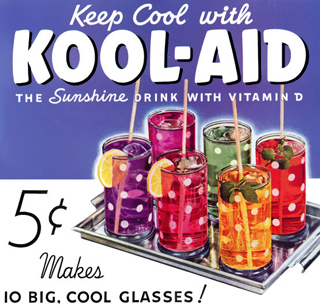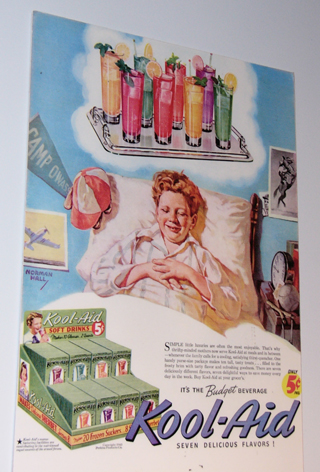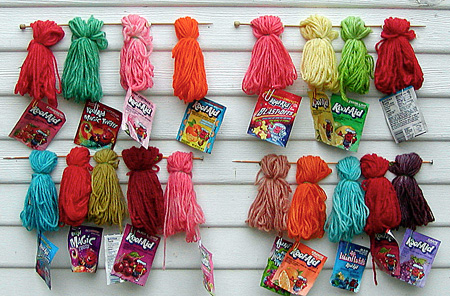Human Flower Project
Dyed Dextrose in a Smiling Pitcher
A cost-cutting soft drink powder, originally made of plant derivatives, helped put Hastings, Nebraska on the map and sweetens the conditions of U.S. soldiers.

1937 Magazine Advertisement for Kool-Aid
Photo: plan59
By James H. Wandersee and Renee M. Clary
EarthScholars™ Research Group
Kool-Aid® originated in Hastings, Nebraska, a small town known mainly for having the largest water fountain between Chicago and Denver. In the late 1920s, when soda pop sold for 5¢ per 6.5-ounce bottle, Kool-Aid® cost just 1¢ for a glassful the same size. During the Great Depression, Kool-Aid® prices were strategically lowered by 50% (from 10¢ to 5¢ per package), so that every family could still afford to mix and serve this ice-cold, fruit-flavored beverage at home.
 “Simple little luxuries are often the most enjoyable”
“Simple little luxuries are often the most enjoyable”
Hastings (NE) Museum of Natural and Cultural History
Photo: EarthScholars Research Group
Edwin Perkins, a resident of Hastings (pop. 16,000 at the time), invented Kool-Aid® (originally called Kool-Ade) in 1927. By 1929 it was selling nation-wide. Available in six flavors—cherry, grape, lemon-lime, orange, raspberry, and strawberry—it was marketed as an economical, refreshing, colorful, summertime drink.
Since soda pop was 90% water and carried expensive shipping, leakage, breakage, and container costs, Perkins reasoned: Why not sell a light-weight, concentrated, powdered drink mix that customers could dilute in water and sweeten to taste? Because household sugar sold for just seven cents per pound in 1925, Kool-Aid® was advertised as a special treat that every mother, even one on a tight grocery budget, could make and serve to a thirsty family.
What’s in a name? As a boy, Edwin Perkins was infatuated by the Genesee Pure Food Company’s innovative powdered dessert mix called Jell-O®, a product that, coincidentally, was also sold in “six delicious flavors.” Later, as a kitchen chemistry enthusiast and savvy-marketing entrepreneur, Perkins gave many of his company’s products clever hyphenated names, including Kool-Ade—a name he was forced to change to Kool-Aid® because government regulators had reserved the –ade suffix for fruit juice products.
How is Kool-Aid® related to plants? The answer lies in its original ingredients: dextrose, citric acid, tartaric acid, flavoring, and food coloring. Dextrose, also called grape sugar, is a natural product of photosynthesis. An isomer of glucose, it is found in honey and sweet fruits. Citric acid is a mild organic acid found in citrus fruits, such as limes and lemons, where it makes up as much as 8% of the dry weight of the fruit. It can be crystallized and ground into a powder. It is used to enhance fruit flavors, adds a sour taste to foods and soft drinks, and also serves as a natural preservative. Tartaric acid is an organic acid that is present in plants, including grapes and bananas. Crystals of it (potassium bitartrate) often form inside wine barrels, and it can be converted to a powder. As a food additive, it is used to impart a crisp, tart taste. Thus, the three major ingredients of the first Kool-Aid® drink mixes were all originally plant-derived. The ingredients listed on today’s Kool-Aid® package are citric acid, calcium phosphate, salt, maltodextrin, modified corn starch, artificial flavor, ascorbic acid, and FD&C red 40 and FD&C blue 1.

Kool-Aid actually makes a good dye for yarns
Photo: via Creative Valerina
All of those ingredients except the dyes are found in the Plant Kingdom. Perkins knew that people associate certain colors with certain fruit flavors and that the color of food can influence the perceived taste. (The U.S. Food and Drug Administration (FDA) and the European Union (EU) have approved the current Kool-Aid® ingredients’ coloring agents as food and drug colorants, though some EU countries have local laws banning food dyes. After extensive laboratory testing, the National Institutes of Health concluded that FDA-approved food color additives do not cause hyperactivity. Nonetheless, we think it is prudent for individuals with sensitivity concerns to examine the pro and con evidence themselves, using the wide range of scientific resources available on the Web.)
Kool-Aid® is the official state soft drink of Nebraska. We recently traveled to Hastings, Nebraska, the town where Kool-Aid® originated (current posted population, 24,064) to visit the world’s only permanent and extensive Kool-Aid® museum exhibition. Kool-Aid: Discover the Dream is housed at the Hastings Museum of Natural and Cultural History. This attractive, well-curated exhibition, including interactive exhibits, occupies an entire wing of the lower level of the museum. It aims to “chronicle the creation of Kool-Aid® from its humble beginnings in Hastings, Nebraska by creator Edwin Perkins to its present day status as an international icon and beloved soft drink.”
Kool-Aid® Days is a festival held annually in August in Hastings. In 2010, the event broke all previous attendance records with over 40,000 participants experiencing 35 fun-filled, Kool-Aid®-related activities and free all-you-can-drink Kool-Aid (14 flavors!) from the world’s largest Kool-Aid® stand.

The Iconic Kool-Aid® Pitcher Shape
Photo: EarthScholars Research Group
One example of the company’s marketing prowess from the 1960s: A plastic, 2-quart Smiling Pitcher was offered to children as a customer premium (for 60¢ plus an empty Kool-Aid® package). By 1964, over 100,000 orders had been received, making it one of General Foods’ most popular premium offers. Inside the pitcher was an additional offer for three matching plastic smiling mugs for 50¢. These were treasured by families and still surface at yard sales today.
Yet as Kool-Aid® became a well-known brand, negative connotations arose. The hackneyed phrase drinking the Kool-Aid® originated with author Tom Wolfe. His 1968 book The Electric Kool-Aid Acid Test describes counterculture gatherings when LSD-laced Kool-Aid was passed out to the public; those who drank this “Kool-Aid” were said to have passed the “Acid Test.” Wolfe did not recognize the registered trademark in print. “Drinking the Kool-Aid®” in a Wolfian context meant taking the hallucinogenic drug LSD (lysergic acid diethylamide).
The same phrase acquired a new, sinister meaning after the infamous 1978 Jonestown mass murder-suicide of hundreds of Peoples Temple cult members in the jungle of Guyana. Popular myth says that they ended their lives by drinking Kool-Aid® laced with a poison and sedative (they actually drank a similar product called Flavor Aid®). In both cases, the product Kool-Aid® became associated with unethical and unhealthy behavior.
But what is the item most requested by soldiers serving in the U.S. armed forces in Iraq and Afghanistan?—“Kool-Aid (pre-sweetened) is needed most of all, because they have to drink that warm water, and it tastes pretty bad [without some flavoring]” (Charles Trentelman, VFW, 2010).
After 82 years of thirst quenching, over 500,000,000 gallons of Kool-Aid are imbibed each year worldwide by ”kids of all generations”—from nostalgic baby boomers to socially networked millennials.

